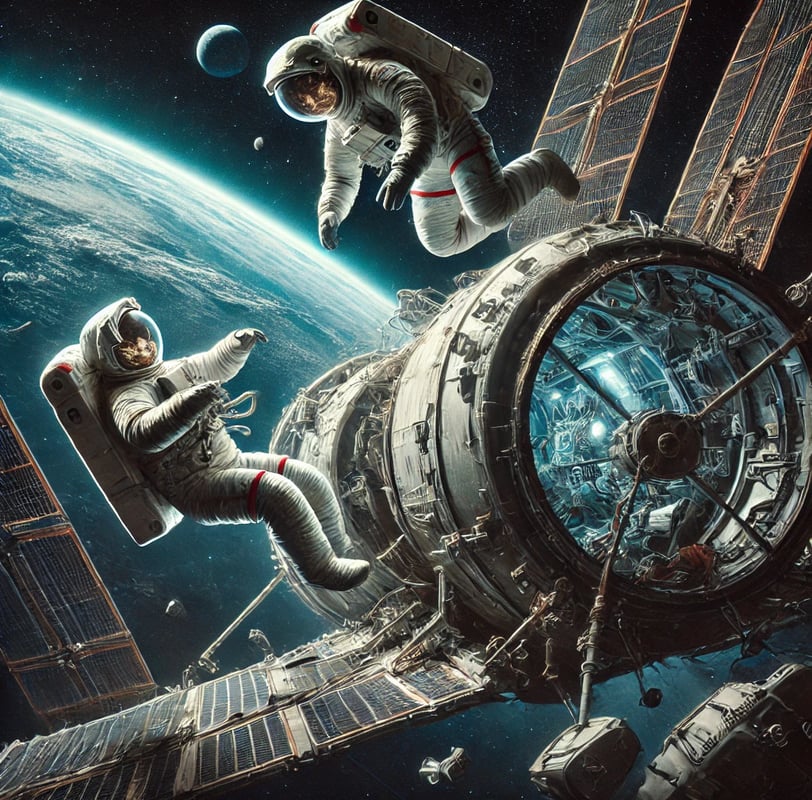Astronauts Trapped in Space: History, Curiosities and Dangers
Since humanity began exploring the cosmos, the risk of being stranded in space has been a constant concern. Despite technological advancements and safety measures, the vastness and hostility of space present challenges that can put astronauts in critical situations. In this article, we explore the history of problematic missions, curiosities about such situations, and the dangers crew members face when isolated in the vacuum of the universe.
3/13/20253 min read


History of Astronauts Trapped in Space
Apollo 13: A Miraculous Rescue
In 1970, the Apollo 13 mission suffered an explosion in one of its oxygen tanks, preventing a lunar landing and putting the crew at risk. Thanks to creative solutions by NASA engineers and the astronauts' bravery, a safe return was improvised, using the lunar module as a temporary shelter.
Salyut 7: The Soviet Rescue Mission
In 1985, the Soviet space station Salyut 7 lost contact with Earth, leaving two cosmonauts without communication and power. A daring rescue mission was carried out, during which engineers managed to reactivate the station and ensure the crew's safety.
The Columbia Space Shuttle Mystery
In 2003, the Columbia disaster occurred during reentry into Earth's atmosphere due to damage to the spacecraft's thermal protection. Had the problem been identified earlier, there was no clear plan to rescue the astronauts, raising concerns about mission safety.
The Case of the Boeing Astronauts
In June 2024, Sunita "Suni" Williams and Barry "Butch" Wilmore departed for the International Space Station (ISS) aboard Boeing's Starliner capsule on a mission originally planned to last only eight days. However, technical failures in the spacecraft prevented their return as scheduled, extending their stay on the ISS for several months.
During this period, the astronauts continued contributing to scientific experiments and maintenance activities. In January 2025, they participated in a five-and-a-half-hour spacewalk to replace a faulty communication device. To ensure a safe return, NASA and SpaceX organized the Crew-10 mission, which arrived at the ISS in March 2025. Finally, Williams and Wilmore returned to Earth aboard SpaceX's Dragon capsule, concluding their unexpectedly prolonged mission.
The Return of the Astronauts Stranded in Space in 2025
After more than nine months aboard the International Space Station, astronauts Sunita "Suni" Williams and Barry "Butch" Wilmore finally returned to Earth on March 18, 2025. Initially, their mission aboard Boeing's Starliner capsule was supposed to last only a few days, but propulsion system failures prevented the spacecraft from safely returning.
During their prolonged stay on the ISS, the astronauts played a crucial role in station maintenance, participating in multiple spacewalks and assisting with ongoing scientific experiments. In January 2025, Williams set a record by becoming the woman with the most accumulated hours in extravehicular activities.
Given the inability to use Starliner, NASA and SpaceX coordinated a rescue operation, sending the Dragon capsule "Freedom" to retrieve the astronauts. The spacecraft undocked from the ISS on March 18, 2025, and safely landed in the Gulf of Mexico, off the coast of Florida, also bringing back astronauts Nick Hague and Alexander Gorbunov, who had been on the station since September 2024.
The return of the astronauts gained global attention, highlighting the importance of contingency strategies for future space explorations.
Curiosities About Astronauts in Risky Situations
Neil Armstrong almost got stranded on the Moon: During the Apollo 11 mission, if the lunar module had failed to take off, there was no rescue plan for Armstrong and Aldrin.
Russian cosmonauts have faced severe failures: In 1971, the Soyuz 11 crew died upon returning to Earth due to unexpected depressurization.
The ISS has emergency supplies: The International Space Station stocks extra food and oxygen to ensure survival in case of issues with return vehicles.
Dangers of Being Trapped in Space
Lack of Oxygen: If the air supply runs out and no rescue is possible, astronauts can suffer hypoxia and die.
Space Radiation: Space is filled with solar and cosmic radiation, which can negatively impact astronauts' health with prolonged exposure.
Psychological Strain and Isolation: Extended isolation can lead to mental health problems such as anxiety and depression.
Failure of Life Support Systems: If a critical system fails and cannot be repaired, survival chances drop drastically.
Conclusion
Despite the risks and challenges faced, space agencies continue to improve technologies and protocols to prevent astronauts from being stranded in space. Stories of resilience and courage prove that space exploration remains one of humanity's greatest challenges, requiring careful planning, innovation, and continuous preparation.
Explore
Discover diverse topics in one convenient hub.
Connect
Learn
contact@mindstormblog.com
© 2025. All rights reserved.


